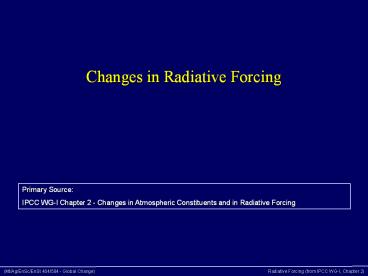Changes in Radiative Forcing - PowerPoint PPT Presentation
Title:
Changes in Radiative Forcing
Description:
IPCC WG-I Chapter 2 - Changes in Atmospheric Constituents ... Sea Salt (Mt/Ag/EnSc/EnSt 404/504 - Global Change) Radiative Forcing (from IPCC WG-I, Chapter 2) ... – PowerPoint PPT presentation
Number of Views:31
Avg rating:3.0/5.0
Title: Changes in Radiative Forcing
1
Changes in Radiative Forcing
Primary Source IPCC WG-I Chapter 2 - Changes
in Atmospheric Constituents and in Radiative
Forcing
2
Key Findings
- Extremely likely (gt 95) that humans have exerted
a substantial warming influence on climate since
1750. - Likely (gt 66) that the human influence by
radiative forcing is at least 5 times greater
than solar influence since 1750. - Exceptionally unlikely (lt 1) that solar
volcanic radiative forcing for 1950-2005 was
comparable to anthropogenic radiative forcing.
3
Major Types of Radiative Forcings
- Changes in
- Greenhouse Gases
- Aerosols (particles)
- Surface albedo
- Contrails
- Solar variability
- Volcanic activity
4
Radiative Forcing Balanced State
Radiative Balance
Radiative-Dynamic Balance
5
Radiative Forcing
Change in net radiative energy flux at the
tropopause with (a) stratospheric temperatures
readjusted to radiative equilibrium (b) surface
and tropospheric temperatures and state held
fixed at original values
(Ramaswamy et al., 2001)
6
Carbon Dioxide (CO2)
Pre-industrial 280 ppm
- Sources
- Fossil fuels
- Cement production
- Deforestation
- Biomass burning
7
CO2 Emissions
- O2 ? as CO2 ?
- Combustion
- Plant respiration/photosynthesis
13C/12C Atmosphere gt Terrestrial Sources
8
Methane (CH4)
- Sources
- Biogenic
- Wetlands
- Rice
- Biomass burning
- Ruminants
- Fossil fuel mining and distribution
- Living vegetation?
NOAA Global Monitoring Division (GMD)
Advanced Global Atmospheric Gases Experiments
(AGAGE)
Mt. Pinatubo?
Warm 1998?
Economic Incentives?
9
Nitrous Oxide (N2O)
- Sources
- Coastal areas
- continental shelves
- estuaries
- rivers
- Land processes
10
Halocarbons
Small amounts, but effective absorbers of
infrared radiation
- Factors
- Industrial processes
- Partly regulated by Montreal Protocol
11
Other Gases
- Stratospheric Ozone
- Tropospheric Ozone
- Stratospheric Water Vapor
12
Aerosol Effects
13
Aerosol Types
- Sulphate
- Organic Carbon from Fossil Fuels
- Black Carbon from Fossil Fuels
- Biomass Burning
- Nitrate
- Mineral Dust
14
Aerosol Distributions
Optical Depth Radiative Thickness White
measurement not possible
Biomass Burning
Mineral Dust
Industrial
Sea Salt
15
Land Use Changes
Albedo Differences Forest lt Cropland Snow-covered
forest lt Snow-covered cropland
16
Other Surface Effects
- Black Carbon on Snow/Ice
- Land-Use Changes on Surface Fluxes
- Anthropogenic Water Vapor Release
- Anthropogenic Energy Release
- CO2 Influence on Plant Physiology
17
Solar Heating Change
Variability due to 1. Changes in sunspots and
faculae 2. Changes in solar diameter?
18
Reconstructed Solar Heating
19
Volcanic Aerosols
20
Time Evolution of Forcing (Representative GCM)
21
Net RF 1750 to 2005
22
END
Changes in Radiative Forcing































